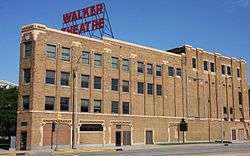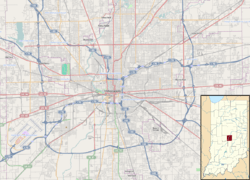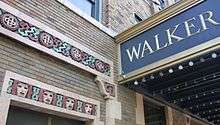Madame Walker Theatre Center
|
Madame C.J. Walker Manufacturing Company | |
 The building in 2016 | |
   | |
| Location | Indianapolis, Indiana |
|---|---|
| Coordinates | 39°46′33.5″N 86°10′1.5″W / 39.775972°N 86.167083°WCoordinates: 39°46′33.5″N 86°10′1.5″W / 39.775972°N 86.167083°W |
| Built | 1927 |
| Architect | Jungclaus, W.; Rubush & Hunter |
| Architectural style | Late 19th and Early 20th Century American Movements |
| NRHP reference # | 80000062[1] |
| Significant dates | |
| Added to NRHP | July 17, 1980 |
| Designated NHL | July 17, 1991[2] |
The Madame C.J. Walker Building houses the Madame Walker Theatre Center in the city of Indianapolis, in the U.S. state of Indiana. It was named after America's first self-made female millionaire, Madam C.J. Walker. As Madame C.J. Walker Manufacturing Company, it was designated a National Historic Landmark in 1991.[2][3]
History
Walker began the development of the Walker Building and Theatre prior to her death in 1919. The project was subsequently completed by her daughter A'Lelia Walker and opened to the public in December 1927.[4]
The Walker Building, located in the Indiana Avenue Cultural District, was a center of entertainment and business and pride for the city's African American community from the 1920s to the 1950s. During the mid-1950s, the building and its surrounding neighborhood began a gradual decline.
By the late 1970 the Walker Building stood nearly abandoned, with only Walker Manufacturing Company remaining housed in the building, and faced demolition. A group of volunteers recognized the structure's history and began a project to preserving the building. After becoming incorporated as the Madame Walker Building Urban Life Center in 1979, the group purchased the building from the Walker Manufacturing Company and began planning for its restoration.
In 1982, the organization's articles of incorporation were amended to reflect the organization's new name of Madame Walker Urban Life Center. The not-for-profit organization was founded to reestablish the facility as a center for cultural expression and economic enterprise.
In 1983, the first phase of the restoration, which housed offices and the Grand Casino Ballroom, was completed. A $2.5 million capital campaign raised funds to restore the famous 944-seat (now 935-seat) Walker Theatre. The influence of African art forms in the original design of Walker and her daughter for the design concept is apparent throughout the theatre.[5] In 1988, the City of Indianapolis celebrated the opening of the fully restored Madame C.J. Walker Building. The site is now designated as a National Historic Landmark, and it is registered on both the Indiana Register of Historic Sites and Structures and the National Register of Historic Places.
In 1996, the Madame Walker Urban Life Center was renamed the Madame Walker Theatre Center to better reflect the organization's purpose. Two office structures along Indiana Avenue—Walker Plaza, built in 1989 and 500 Place, were completed in 1992.
Performing arts
The Madame Walker Theatre Center's annual performing arts season opens in early October and continues until early May. Monthly presentations include:
- Jazz on the Avenue, with jazz artists in concert on the Main Stage or in a cabaret setting and the Indiana Avenue Renaissance Festival. These programs present local and national artists and aim to educated the community in jazz as an indigenous American art form.
- Steppin' on the Avenue, presenting stepping in African American life, as part of the way in which music, song and dance are interrelated in that culture. The program promotes an art form similar to Salsa.
- Laughin' on the Avenue, showcasing local and national artists.
- Main Stage Series: these programs are primarily presented in the Madame Walker Theatre and include theatre, music and dance. In some cases, international artists presented under the category of Cultural Connections, usually showcased through workshops and classes, are also presented as part of the Main Stage season.
Artists presented are in many cases in residence at the theatre for two or more days, which aims to allow them to develop and participate in community residency, education and humanities programming.
Educational programs
In 1987, the Madame Walker Theatre Center launched the Youth-in-Arts program, which target more than 150 youth who may not have the resources to experience the arts outside of their typical school setting.
In 2007, the program was redesigned and now consists of three subprograms, approaching the arts through performance and scholarship, targeting students, teachers and parents:
- Project MAPPED, an acronym for Music, Art, Poetry, Performance, Expression, and Dance, is a 12-week interdisciplinary arts curriculum offered 3 days a week in 2-hour intervals targeting grades 3 through 12 and serving students on all performance levels. The program offers chorus & individual voice lessons, string orchestra & individual string lessons, poetry & spoken-word writing, speech lessons, set production & visual arts, and dance (modern, ballet, jazz, tap, and hip hop). Each session culminates with a semiprofessional performance on stage at the Madame Walker Theatre. The sessions are assigned themes dictated by specific historical events or phenomena within American and African-American culture. Students participate in workshops, lecture-demonstrations, and concerts aimed at introducing them to business practices in the music industry, and the creative processes and aesthetics of various genres.
- Crushing the Conventional is a concert/lecture/master class series for students, educators and parents showcasing traditional and nontraditional art forms within the African and African-American Diaspora. Admission to these matinee performances is set at an affordable rate. The series occurs during the school day and includes master classes and lectures for parents.
- Beyond the Wings is an Arts Administration introductory training initiative of the Center targeting high school students. The program exposes students to basic arts administrative duties and teaches arts administration, with students collecting community service credits which many are required to obtain on a semester basis.
- Arts in Education provides arts experiences to Indianapolis Public School students and students in private, suburban and outlying school districts. The program utilizes artists in residence who are participating in humanities or performing arts programs to provide workshops, master classes, lecture-demonstrations and mini-concerts that educate the student to the process, technique and aesthetics of various art forms. The Arts in Education program also includes the Children's Performing Arts Series, which allows students to attend matinée performances at the Madame Walker Theatre.
- Madame Walker Academy for Girls provides intermediate-level refinement skills to an underserved segment of the Indianapolis community. Through an ongoing series of workshops, lectures and activities, participants graduate from the academy with new presentation skills for a variety of settings. The program is open to girls ages 11–17.
- Humanities: the Madame Walker Theatre Center's programming for the humanities is designed to encourage participation at all ages.
- Writer's Symposium Series, an ongoing program of the Center designed to familiarize participants with the written word and its place in American culture. The program presents a series of dialogues based in and around the works of local, regional and national authors.
- Walker Film Series, a series of films designed to bring visibility to national and international film and video with emphasis on African and African-American and other ethnic minority filmmakers.
- Tours & Living History: The Heritage Center serves as a display space and repository for information regarding C.J. Walker's life and legacy', as well as the lives of African-Americans who have contributed to American culture. This street-level space offers tours, lectures and small heritage programs presented by local living history theatre Freetown Village.
The Center also provides facilities for Freetown Village and Iibada Dance Company. It serves as a rental facility for other arts, social, civic and business organizations to host their programs and activities.
Madame Walker Theatre

The Madame Walker Theatre is used for pageants, musicals, concerts, lecturers, auditions and rehearsals, motion picture and video screenings, ceremonial awards presentations and other community events.
Features of the theatre include; Seating capacity of 935, professional lighting and sound, full stage with an Austrian-hung grand drape and fully equipped dressing rooms, lobby, box office services, bar lounge, catering and technical services, and free, secure parking
Additional event venues include the Grand Casino Ball Room, Walker Memorial Board Room and A'Lelia Bundles Conference Center.
The Madame Walker Theatre contains one of the few remaining African-Art Deco architectural motifs in the country. The interior ornamentation includes 150 original colors hand-applied during restoration, an Egyptian statuary, cubist-inspired African masks, 20-foot (6.1 m) spears and brass embellishments highlighted with a regal design, dramatic detail and plush seating.
References
- ↑ National Park Service (2006-03-15). "National Register Information System". National Register of Historic Places. National Park Service.
- 1 2 "Madame C.J. Walker Manufacturing Company". National Historic Landmarks Program. National Park Service. Archived from the original on 2009-01-14. Retrieved 2009-06-05.
- ↑ Miller, Paige Putnam (June 4, 1990). "National Historic Landmark Nomination: Madame C.J. Walker Building". National Park Service. and Accompanying four photos from 1990
- ↑ "Madame C. J. Walker Building--Indianapolis: A Discover Our Shared Heritage Travel Itinerary". www.nps.gov. Retrieved 2016-04-08.
- ↑ "Madame Walker Theatre Center - Visit Indy". www.visitindy.com. Retrieved 2016-04-08.
External links
- walkertheatre.com Official site
- “Two American Entrepreneurs: Madam C. J. Walker and J.C. Penney”, a National Park Service Teaching with Historic Places (TwHP) lesson plan
- Madame C. J. Walker Building from Indianapolis, a National Park Service Discover Our Shared Heritage Travel Itinerary
- Official Madam Walker Biography site